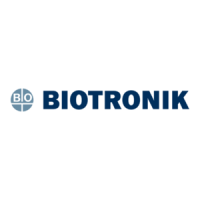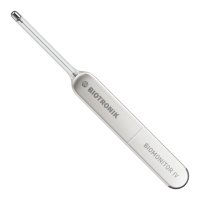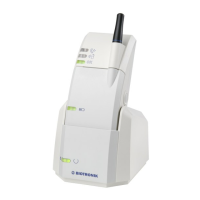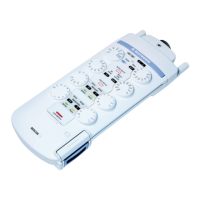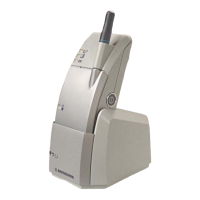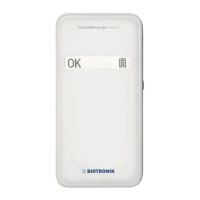Do you have a question about the BIOTRONIK ICS 3000 and is the answer not in the manual?
For use by physicians and trained personnel with medical understanding.
ECG connection safety, BF-type part, defibrillation-proof with approved cable.
Never simultaneously touch patient and SELV connector components.
Do not use ICS 3000 with RF-surgical equipment.
Keep emergency equipment ready during diagnosis/therapy.
Guidelines for combining medical devices safely, focusing on power supply and leakage currents.
Table detailing maximum permissible leakage currents under normal and single fault conditions.
Connecting additional devices may exceed leakage limits; ensure compliance and documentation.
Use only BIOTRONIK-approved accessories to maintain EMC and safety standards.
Unapproved accessories can impair EMC, cause leakage issues, and cause functional disturbances.
Safety precautions for patient cables and connector components.
Specifies where and how the ICS 3000 can be operated safely.
Use only the BIOTRONIK power supply cable.
Do not use ICS 3000 with electrosurgical instruments simultaneously.
Avoid rapid succession parameter changes to prevent unintended results.
ICS 3000 meets EN 60601-1-2 requirements for EMC.
Avoid strong electromagnetic fields which can impair function.
Pay attention to device disturbances like power-down or unexpected events.
Steps to take when experiencing interference, including turning off devices and moving equipment.
Handle the ICS 3000 with care to prevent damage from improper handling or mechanical impact.
ICS 3000 is NOT to be used as a life support system.
Detach Operation Module using the release button to avoid damaging the locking mechanism.
Do not operate or store in direct sunlight or near heat sources to prevent damage.
Never close or block the ventilation slots.
Never remove the label from the ICS 3000 housing.
Do not sterilize the ICS 3000.
Do not operate near flammable or explosive materials.
Use only in medical spaces with grounded AC.
Cover programming head and cable with a sterile cover in the operating room.
Use safe program function only under direct physician supervision.
Safety precautions during external defibrillation.
Do not touch the programmer or accessories during defibrillation.
Place defibrillator electrodes at least 10 cm away from implanted electrodes.
Set energy level no higher than required for defibrillation.
Check all ICS 3000 functions after external defibrillation.
Device cannot be used during self-test; do not switch off during examination.
Steps and indicators for powering on the ICS 3000 system.
How to use the On/Off button for system startup.
Procedure for a normal system shutdown using the On/Off button.
How to force a system shutdown if the software is unresponsive.
In emergencies, unplug the device; On/Off button has a delay.
Details on the automatic battery recharging process after shutdown.
How to connect the Operation Module to the Docking Station.
How telemetry works between the programmer and implant via the PGH.
Caution regarding the strong magnet in the PGH and sensitive objects.
The PGH has its own safe program button, similar to the Operation Module.
Use the safe program function only under direct physician supervision.
Bidirectional communication with implants via the programming head.
Triggering safe program and emergency shock functions.
Trigger safe program or emergency shock only under physician supervision.
Step-by-step guide to activating the safe program.
How to issue an emergency shock command via the hardware button.
Keep an external defibrillator available when using NIPS.
Perform maintenance tasks only when the device is unplugged.
Never use organic solvents like ether or acetone for cleaning.
The ICS 3000 itself should not be sterilized.
Cable types, dimensions, weight, connection, and protection degree of the PGH.
Guidelines for operating the ICS 3000 in a suitable electromagnetic environment.
Information on the device's immunity to interference and test levels.
Details test levels for ESD, transient interference, surges, and voltage fluctuations.
Recommended minimum distances from transmitters like mobile phones.
Test levels and guidelines for conducted RF interference.
Test levels and guidelines for radiated RF interference.
| Manufacturer | BIOTRONIK |
|---|---|
| Weight | Not found |
| Display | N/A (Implanted device) |
| Battery Chemistry | Lithium-based |
| MRI Conditional | MRI conditional with specific conditions |
